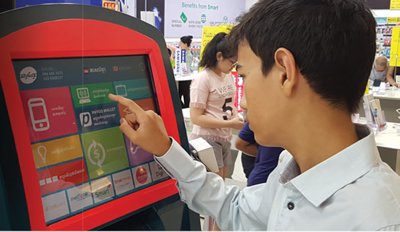As part of the eTrade for all initiative, eTrade readiness assessments for Bhutan and Cambodia were conducted to provide a rapid analysis of the current e-commerce situation and identify opportunities, barriers and relevant policy measures.
In the changing global marketplace, e-commerce presents a powerful driver of economic growth, inclusive trade and job-creation in the least developed countries (LDCs).
However, due to a lack of e-commerce infrastructure and other barriers in LDCs, many people and small businesses are not in a position to use the Internet, particularly broadband. These obstacles prevent people from effectively leveraging e-commerce to seize economic opportunities.
UNCTAD, in partnership with the governments of Cambodia and Bhutan have released "Rapid eTrade Readiness Assessments" for Bhutan and Cambodia during the Special Session on Assessing eTrade Readiness of the Least Developed Countries at UNCTAD E-Commerce Week.
The assessments identify the current e-commerce situation in both countries, plus opportunities and challenges. They also point to concrete actions to advance e-commerce development.
"These assessments will tremendously support the formulation of strategies and policies that harness the power of digital trade, improve economic growth and sustainable development," said UNCTAD Secretary-General Mukhisa Kituyi.
"The e-Trade Readiness assessment comes with a set of robust actions to be considered by different stakeholders in Cambodia and outside to support the rapid adoption of the so-called digital revolutions", said HE Pan Sorasak, Minister of Commerce, Royal Government of Cambodia.
He added that the adoption of an e-Commerce Law, the development of mobile money platforms and the update of ICT-related curricula were already being implemented.
Whilst Cambodia has not yet developed an ICT or an e-commerce strategy, e-commerce has huge potential in the region and is becoming more visible.
E-commerce is particularly relevant to the country because of Cambodia's IT-hungry urban middle class that has emerged over the past 10 years and the fact that 60 % of the population are below the age of 25. With a population of more than 15.4 million, Cambodia is a "mobile first" market. The majority of Cambodians go online via their mobile device, with 20.5 million mobile subscribers. However, the majority of Cambodians are unbanked: 22 % had bank accounts in 2014, 39,000 possessed credit cards, and 10 % of the population had bank cards. (Source: World Bank, 2015)
While the vast majority of e-commerce transactions are for imports or domestic trade, there are no statistics available on foreign eTrade volume. Online exports are limited to tourism and handicrafts including through the Government-led e-visa system.
The demand for e-commerce is currently limited to products that customers cannot find through regular retail outlets. Consumers prefer traditional markets or retail stores and the financial markets still rely on cash.
"We need to ensure dialogue happens and strives, and that our private sector understands how ICT is changing the way we are doing business," said Mr. Sorasak
In Cambodia, 90% of the online population is using Facebook. There is a real opportunity for small entrepreneurs to sell products online mainly through Facebook or Instagram platforms.
The transformation of Cambodia into a digital economy is advancing with rapid improvements in internet accessibility and affordability. The Ministry of Posts and Telecommunications expects the number of citizens with regular Internet access to almost double to 9.5 million by 2020 (60 % of the population).
Cambodia has considerable advantages that could be leveraged to create ICT jobs and benefit the national economy, such as the highest rate of Internet connectivity growth in the Asia-Pacific region and a very young population.
Over the coming years, enhanced connectivity will continue to create new opportunities and online platforms for Cambodian businesses to reach customers. If effectively harnessed, these opportunities can significantly improve financial performance and contribute to economic growth and sustainable development.
E-commerce, however, remains limited compared to other Association of Southeast Asian Nations, and the potential for export development is relatively low. Despite recent progress, Cambodia ranked only 119 out of 137 in the UNCTAD B2C e-commerce index 2016.
Both Bhutan and Cambodia face similar challenges, including a relatively small market size, low broadband Internet penetration (especially in rural areas), payment issues and poor logistics networks which remain stumbling blocks to e-commerce development.
Some of the other key barriers to developing e-commerce include:
Confusion within and between relevant government agencies and public institutions over priorities and implementation processes.
Technical factors, including accessibility and affordability of broadband Internet infrastructure, the digital divide between cities and the countryside; limited access to financial services, and logistical challenges related to the delivery of goods.
Trust factors, i.e. moving from a cash to a cashless society, building consumer trust in online platforms and mobile payment solutions.
Unclear legal and regulatory framework.
Focus on copying existing platforms for quick return rather than on innovating or investing in new skills and knowledge to bridge a persistent market mismatch.
"We thank UNCTAD for the rapid eTrade assessment" said H.E. Mr Lekey Dorji, Minister for Economic Affairs, adding "It was a very good guide for Bhutan".
The two assessments were supported by the government of Sweden. More pledges from other partners continue to be announced, such as a 300,000€ pledge from the government of Germany for conducing eTrade readiness assessments in LDC. The EIF has also announced the funding of two eTrade Readiness assessments in Samoa and Liberia.

